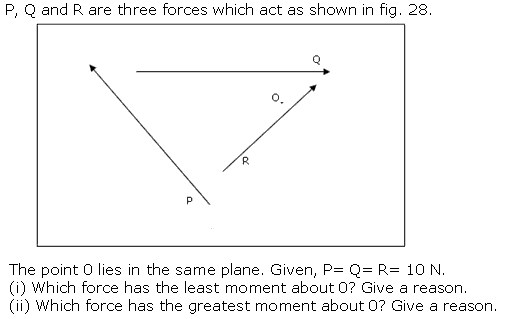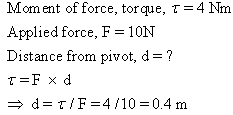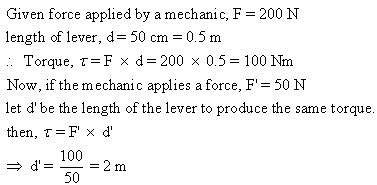Chapter 1.1 - Turning Effect of Force and Equilibrium Exercise 13
Question 1
Define moment of force and state its SI unit.
Solution 1
The turning effect produced by a force on a rigid body about a point, pivot or fulcrum is called the moment of force or torque. It is measured by the product of force and the perpendicular distance of the pivot from the line of action of force.
Moment of a force = Force x perpendicular distance of the pivot from the force.
Its SI unit is newton-metre (Nm).
Moment of a force = Force x perpendicular distance of the pivot from the force.
Its SI unit is newton-metre (Nm).
Question 2
Why is easier to open a door by applying the force at its free end?
Solution 2
This is so because near the free end, the distance of the point of application of force from the axis of rotation becomes maximum, so the torque (= Force x perpendicular distance of the pivot from the force) is very large and hence it is easier to open the door.
Question 3
Why does a spanner have a long handle?
Solution 3
A long handle facilitates increased torque with small application of force; hence a spanner has a long handle.
Question 4
What do you mean by equilibrium of a body?
Solution 4
A body is said to be in equilibrium under the action of a number of forces, if the forces are not able to produce any change in the state of rest or of uniform motion or uniform rotation.
Equilibrium is a state of zero acceleration.
Equilibrium is a state of zero acceleration.
Question 5
State the condition when a body is in (i) static, (ii) dynamic, equilibrium. Give one example each of static and dynamic equilibrium.
Solution 5
(i) The conditions for static equilibrium are:
(a) The sum of the (vector) forces must equal zero, i.e. ? F = 0
(b) The sum of the torques must equal zero; i.e. ? ? = 0.
(ii) The conditions for dynamic equilibrium are:
(a) The body should have a broad base.
(b) Centre of gravity of the body should be as low as possible.
(c) Vertical line drawn from the centre of gravity should fall within the base of the support.
Examples:
Static equilibrium: a box at rest on a floor; there is a gravitational force pulling the object to the earth, but there is also an equal and opposite force applied by the floor to the box (pushing up).
Dynamic equilibrium: A rock travelling across the cosmos, far enough away from any other object (so as not to be affected by gravity - in other words, in zero gravity conditions); the rock continues to travel in a straight line at uniform velocity either for eternity, or until acted upon by an external unbalanced force.
(a) The sum of the (vector) forces must equal zero, i.e. ? F = 0
(b) The sum of the torques must equal zero; i.e. ? ? = 0.
(ii) The conditions for dynamic equilibrium are:
(a) The body should have a broad base.
(b) Centre of gravity of the body should be as low as possible.
(c) Vertical line drawn from the centre of gravity should fall within the base of the support.
Examples:
Static equilibrium: a box at rest on a floor; there is a gravitational force pulling the object to the earth, but there is also an equal and opposite force applied by the floor to the box (pushing up).
Dynamic equilibrium: A rock travelling across the cosmos, far enough away from any other object (so as not to be affected by gravity - in other words, in zero gravity conditions); the rock continues to travel in a straight line at uniform velocity either for eternity, or until acted upon by an external unbalanced force.
Question 6
State two conditions for a body acted upon by several forces to be in equilibrium.
Solution 6
Conditions for equilibrium:
(a) Vector sum of forces acting on the body should be zero.
(b) Algebraic sum of moments acting on the body should be zero.
(a) Vector sum of forces acting on the body should be zero.
(b) Algebraic sum of moments acting on the body should be zero.
Question 7
State the principle of moments.
Solution 7
Principle of moments: If a body is in equilibrium under the action of number of force, then the sum of clockwise moments is equal to the sum of anticlockwise moments.
Question 8
Draw a neat labeled diagram to show the direction of two forces acting on a body to produce rotation in it. Also mark the point about which rotation takes place.
Solution 8
Question 9
Give two examples of couple action in our daily life.
Solution 9
Examples of couple action in daily life:
(i) Opening and closing the cap of a bottle
(ii) Turning a key in a lock
(i) Opening and closing the cap of a bottle
(ii) Turning a key in a lock
Question 10

Solution 10
(i) Force 'R' has the least moment about 'O' because its perpendicular distance is least from 'O'.
(ii) Force 'P' has the maximum moment about 'O' because its perpendicular distance is maximum from 'O'.
(ii) Force 'P' has the maximum moment about 'O' because its perpendicular distance is maximum from 'O'.
Question 11
Its moment of a force scalar or a vector quantity?
Solution 11
The moment of force is a vector quantity.
Question 12
Name the physical quantity whose SI unit is Nm.
Solution 12
Torque
Question 13
What is meant by a translational motion? Give one example.
Solution 13
When some force is applied on a rigid body free to move and the body starts moving along a straight path in the direction of force. This is known as linear or translational motion. Points on the rigid body, undergo displacements forming parallel lines and magnitude of displacement is the same for individual point.
e.g. the motion of a bullet fired from a gun, a ball thrown straight up and falling back straight down.
e.g. the motion of a bullet fired from a gun, a ball thrown straight up and falling back straight down.
Question 14
What is meant by a rotatory motion? Give one example.
Solution 14
If a rigid body is pivoted at a point, then the applied force will rotate the body about the fixed point or about the axis passing through the fixed point. This motion is called rotational motion.
e.g. Earth's rotation about its axis, wheels of car in motion.
e.g. Earth's rotation about its axis, wheels of car in motion.
Question 15
What is the relationship between Nm and dyne cm?
Solution 15
1 Nm = 107 dyne cm
Question 16
State the factors on which moment of force about a point depends.
Solution 16
The factors on which the moment of force about a point depends are:
1. The magnitude of force applied.
2. The distance of the line of action of the force from the axis of rotation.
1. The magnitude of force applied.
2. The distance of the line of action of the force from the axis of rotation.
Question 17
What do you understand by the clockwise and anti clockwise moment of force?
Solution 17
If the turning effect on the body is clockwise, moment of force is called the clockwise moment and is taken as negative.
If the turning effect on the body is anticlockwise, moment of force is called the anticlockwise moment and is taken as positive.
If the turning effect on the body is anticlockwise, moment of force is called the anticlockwise moment and is taken as positive.
Question 18
State the condition when a force produces
(i) linear motion.
(ii) rotational motion, in a body.
(i) linear motion.
(ii) rotational motion, in a body.
Solution 18
(i) If a rigid body is free to move, the applied force will cause translational motion.
(ii) If a rigid body moves around a center or is pivoted at a point, the applied force will cause rotational motion.
(ii) If a rigid body moves around a center or is pivoted at a point, the applied force will cause rotational motion.
Chapter 1.1 - Turning Effect of Force and Equilibrium Exercise 14
Question 1
What do you understand by the term couple? State its effect.
Solution 1
Two equal and opposite parallel forces acting along different lines on a body constitute a couple.
Effect of couple: It produces angular acceleration.
Effect of couple: It produces angular acceleration.
Question 2
Define moment of couple. Write its S.I. unit. Prove that
Moment of couple= Force x Couple arm.
Moment of couple= Force x Couple arm.
Solution 2
The turning effect of a couple is called the moment of couple and is calculated by the product of either of the forces and the perpendicular distance between them.
Its SI unit is Nm.
Its SI unit is Nm.
Question 3
A body is provided at a point. A force of 20 N is applied at a distance of 40 cm from the pivot. Find the moment of force about the pivot.
Solution 3

Question 4
The moment of a force 10 N about a point 0 is 4 Nm. Calculate the distance of point of application of force from the point 0.
Solution 4

Question 5
A mechanic can open a nut by applying a force of 200 N while using a lever handle of 50 cm length. How long handle is required if he wants to open it by applying a force of only 50 N?
Solution 5

Question 6
State the conditions of equilibrium for a rigid body.
Solution 6
Conditions of equilibrium for a rigid body:
1. The body should have a broad base.
2. Center of gravity of the body should be as low as possible.
3. Vertical line drawn from the center of gravity should fall within the base of
support.
4. Vector sum of forces acting on the body should be zero.
5. Algebraic sum of moments acting on the body should be zero.
1. The body should have a broad base.
2. Center of gravity of the body should be as low as possible.
3. Vertical line drawn from the center of gravity should fall within the base of
support.
4. Vector sum of forces acting on the body should be zero.
5. Algebraic sum of moments acting on the body should be zero.

0 comments:
Post a Comment